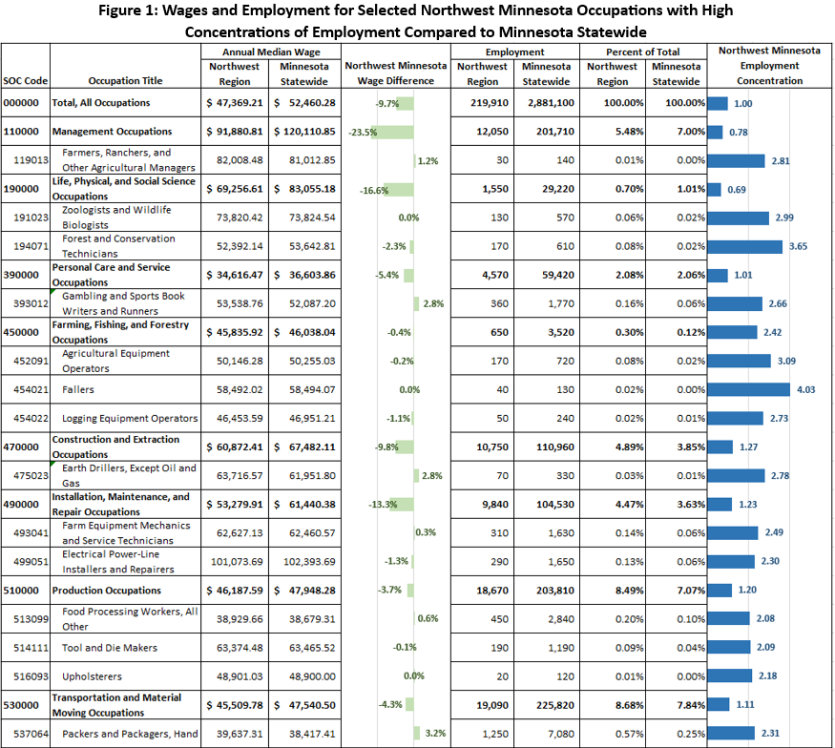 The presence of such industry powerhouses as Polaris, Arctic Cat and New Flyer make Northwest Minnesota a hub of transportation equipment manufacturing.
The presence of such industry powerhouses as Polaris, Arctic Cat and New Flyer make Northwest Minnesota a hub of transportation equipment manufacturing.
From wheat and potatoes to soybeans and sugar beets, the region is a major producer and processor of food staples and specialty agricultural products.
Want the freshest data delivered by email? Subscribe to our regional newsletters.
5/28/2024 1:00:40 PM
Anthony Schaffhauser
While it is well known that Northwest Minnesota wages are generally lower than statewide wages, there are unique features of the Northwest that make wages for some occupations similar or even higher. Advantages are often reflected in high concentrations of employment in certain occupations. It stands to reason that if a region has a competitive advantage in certain economic activities, there is likely to be a concentration of regional employment supporting those activities. Figure 1 identifies selected occupations with high employment concentrations and relatively high wages compared to Minnesota statewide. Only a small, manageable sample of highly concentrated occupations are featured here.

For all occupations, Northwest wages are 9.7% lower than statewide, with a median annual wage of $47,369 compared to $52,460 for Minnesota. This reflects the fact that the majority of jobs are in the higher paying, and higher cost of living, Twin Cities Metro Area. Specifically, an estimated 1,743,500 of the 2,881,100 jobs in the state, or just over 60% of Minnesota jobs are in the Twin Cities. The Twin Cities Metro has larger employers, including corporate headquarters, with highly paid employees. Also, large metro areas attract many top specialists due to the large market served. Large metro areas also tend to have higher-priced real estate, and higher cost of living in general.
The basic needs cost of living in the Twin Cities reflects this higher cost of living. For an average family of a partnered couple with one child where one parent works full-time and one part-time, the basic needs cost of living is $67,716 in the Twin Cities. In the Northwest, the same family's basic needs cost of living is $49,320. That's a difference of $18,396, or 37% less in the Northwest. Higher wages in the Twin Cities makes sense. The Northwest has the second lowest basic needs cost of living of Minnesota's six planning regions (with the Southwest lowest at $47,448 for this average family).
Thus, it is remarkable for the Northwest to have similar or higher wages than statewide. Figure 1 includes the broad occupation group as well as the selected specific occupations to show that often similar occupations in these groups are closer in wage to statewide than the total of all occupations. However, some groups are even further from the statewide wage. For example, Management occupations as a group have wages that are 23.5% lower in the Northwest. Life, Physical & Social Science occupations are 16.6% lower. These two broad occupational groups also have relatively low employment concentrations in the Northwest. Management is 0.78 the concentration of statewide, while Life, Physical & Social Science is 0.69 as concentrated. The group with the highest concentration is Farming, Fishing & Forestry with 2.42 times the statewide percentage of employment. It is also the group that is closest to statewide wages.
Indeed, the Northwest's natural resources provide competitive advantage that allows workers to add great value to the goods and services produced, thereby reaping higher wages. Occupations from Farmers, Ranchers & Other Agricultural Managers, to Zoologists & Wildlife Biologists, to Forest & Conservation Technicians, to Agricultural Equipment Operators, to Farm Equipment Mechanics, to Food Processing Workers, to Packers & Packagers all add value to the natural resources of the region, making their work relatively highly compensated.
Seven of Minnesota's 18 Native American Casinos are in the Northwest Region, and Gambling Runners are instrumental to these operations. No doubt the region's natural beauty attracts tourists to support these operations. Likewise, Upholsterers are essential for the Transportation Equipment Manufacturing industry that builds boats, ATVs, and snowmobiles that are used to recreate in the region.
Electrical Power-Line Installers & Repairers enable electricity to be moved through the vast region, while Earth Drillers (directional drillers) install utilities through rural distribution areas where trees and wetlands make overhead lines or trenching less feasible. Thus, the challenges of distance and natural features also lead to high value-added occupations.
An important implication of this analysis is that a young person who wants to live in the Northwest could choose one of these highly concentrated occupations for a career in order to earn close to the same or higher wages compared to statewide and have even more purchasing power considering the much lower cost of living.
I am not recommending this should be the main criteria for a choice of career, as interest and aptitude are foremost. Then, Occupations in Demand is the first labor market information tool to consult. However, if a person had a strong desire to stay in the region, it might be a factor in choosing one career over a similar one, for example, choosing wildlife biology rather than ecology, or choosing Tool & Die Making over Model Making.
Contact Anthony Schaffhauser at anthony.schaffhauser@state.mn.us.